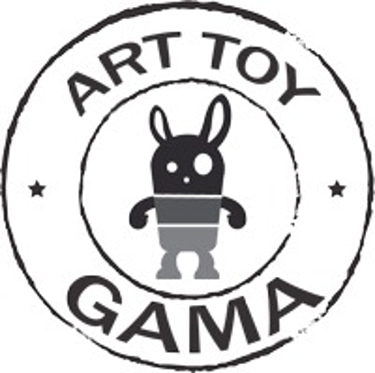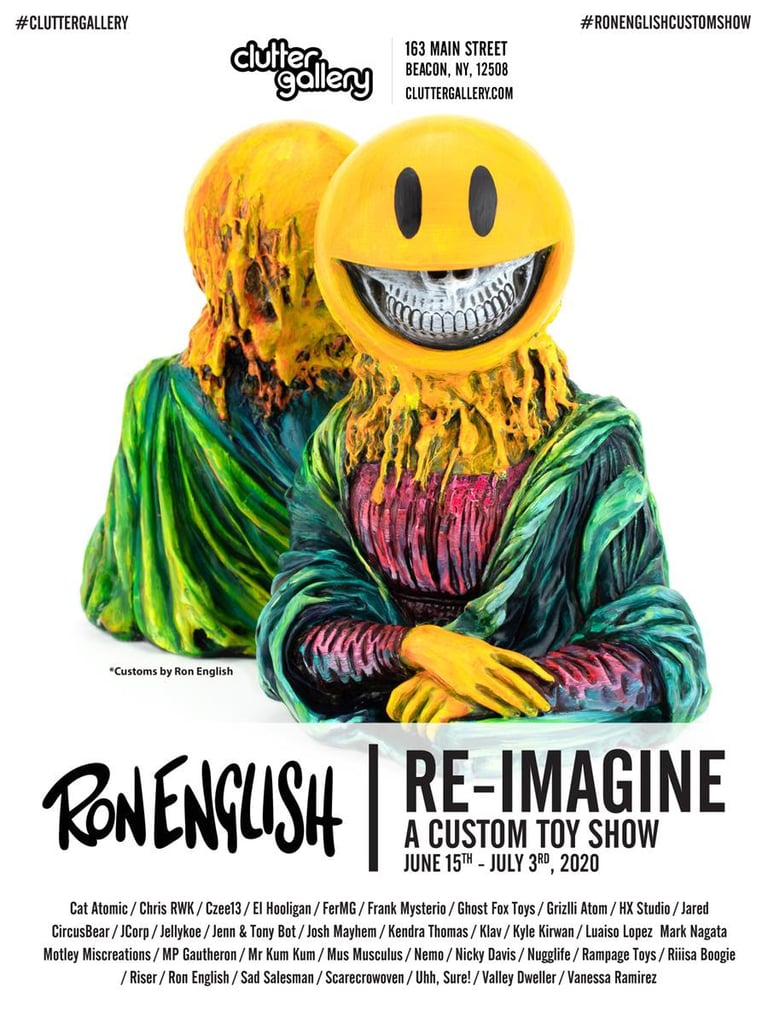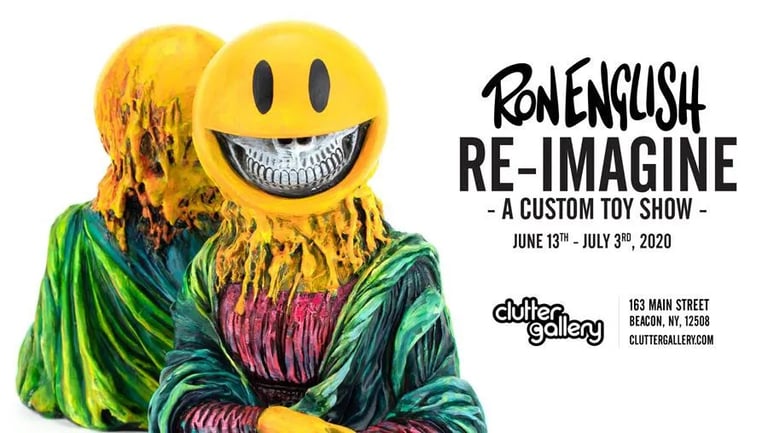We didn’t lose our inner child. We turned it into ArT Toys and More...with purpose.
😶🌫️ RE-IMAGINE — Ron English x Clutter Gallery
RE-IMAGINE : A Custom Toy Show with Ron English and more. When the Smiley learned to grin back. (Beacon, New York • June 2020) #00013— TNoTToys Publications
TNOTTOYS PUBLICATIONS1000 ICONIC ART TOY EXHIBITIONS
Sergio Pampliega Campo & Cristina A. del Chicca
🌀 This post is part of an ongoing research series from Art Toy Gama’s editorial division:
📚 This Is Not a Book About Art Toy Exhibitions & ToyCons
Our Upcoming Art Toy Book: 1000 Iconic ArTToy Exhibitions
Context
June 2020. The world was still trembling under the shadow of COVID-19. Masks, distance, canceled fairs. Culture itself felt suspended. And then, in Beacon, NY, Clutter Gallery reopened its doors: ten people at a time, no crowded reception, strict protocols.
In that fragile pause they lit a fuse: RE-IMAGINE: A Custom Toy Show.
More than thirty artists from across the globe joined forces with Ron English, the satirist who built an empire out of billboards, mascots, and corrupted smileys. His icons — the SmileyGrin, MC Supersized, even his warped saints — were handed over to a community ready to bend them, distort them, rewrite them. This wasn’t nostalgia. It was an operating theater.
POSTER Reading. Poster Analysis. What the image really says
The POSTER was not a piece of graphic design. It was a painted provocation. A one-of-a-kind Mona Grin vinyl figure by Ron English himself, elevated into the face of the Exhibition.
The yellow head gleamed like an airbrushed halo, until the mouth betrayed it: a skeletal chrome grin carved into the mask of joy. The robe bled into toxic greens and hallucinatory magentas, half saint, half chemical spill. Behind it, a shadow double hovered: a ghostly echo, a reminder that every icon always carries another reading.
Typography staged its own duel: English’s jagged signature against Clutter’s clean sans serif. Artist versus institution. Pop chaos framed by gallery order. The palette screamed alarm: acid yellows, electric pinks, corrosive greens. Not the candy tones of kawaii, but a siren warning: satire ahead.
The POSTER didn’t just advertise the show. It announced the method. Pop mythology doesn’t survive by being archived. It survives by mutating in the hands of those daring enough to rewrite it.
The Exhibition
For three weeks, Beacon became a laboratory. English unveiled his own custom ArT Toys and drawings, but the real electricity came from the swarm of more than thirty international artists. They seized his icons and rewired them.
Resin drips. Flocked textures. Grotesque remixes. Tender reinterpretations. A kaleidoscope of voices that turned the Show into a living archive of mutation. Some pieces leaned toward the sweet, others toward the grotesque, and many danced in that uneasy territory where humor and discomfort can’t be separated.
Visitors arrived in careful waves. Online, the catalog emptied quickly. Clutter transformed restrictions into infrastructure: physical gallery plus digital sales, survival strategy plus cultural Manifesto.
Why It Mattered
RE-IMAGINE was more than an Exhibition. It was a manual.
In 2020 the world itself needed re-imagining. If ArT Toys could be torn down and rebuilt into something new, maybe systems could too. The custom Show became metaphor: cut, repaint, rewrite.
Ron English’s private mythology — smileys, obese mascots, parodied saints — was handed over to a community, democratized, hacked in public. What had once been author’s canon became collective language.
And in the vacuum left by canceled fairs and frozen markets, Clutter’s hybrid model kept the emotional engine of collecting alive. Resilience disguised as play. The exhibition made one thing undeniable: ArT Toys are not decorations. They are scalpels made of vinyl, sharp enough to dissect pop culture, expose its machinery, and offer it back reprogrammed.
Legacy & Mutation
To re-imagine an ArT Toy is to re-imagine reality.
The SmileyGrin made that clear: every grin hides a cost. Every icon can be melted down and cast again. Pop is not sacred. It is clay. And clay demands new hands, new voices, new mutations.
Clutter Gallery was the perfect stage. Born first as Clutter Magazine in the early 2000s, it chronicled the global rise of designer toys, pop art, and lowbrow long before opening its physical gallery in 2011. From Beacon, it has championed artists who push the edges of character design, street art, and pop surrealism. Their signature: Custom Toy Shows where the pulse of the movement can be felt most.
RE-IMAGINE left us with one truth: the myth is never fixed. It mutates every time an artist dares to touch it.
Biography in Brief
Ron English has spent decades turning mass culture against itself. From hacking billboards in the 1980s to creating the SmileyGrin and MC Supersized, his Popaganda stripped logos and mascots of innocence and revealed their toxic underbelly.
Clutter, his partner for this experiment, is more than a Gallery. Born out of its magazine roots, it became the first physical space fully dedicated to treating ArT Toys as Gallery-worthy Art. Known for producing vinyl with artists and staging groundbreaking custom Shows, Clutter has become a vital node in the Movement: part archive, part marketplace, part amplifier.
Together, English and Clutter didn’t just stage a Show. They staged a rehearsal for how culture could survive, mutate, and move forward.
Final Thought from Art Toy Gama
At Art Toy Gama we hold a law: the ordinary must be made impossible to ignore.
RE-IMAGINE lived that law. A smiley so banal it should fade into wallpaper was split open, filled with skull and satire, multiplied into thirty new voices. Each collector left not just with a toy, but with proof that icons are not sacred. They are malleable. They belong to whoever dares to re-code them.
This is the true power of ArT Toys. They are not passive. They are living mutations. They disguise critique in Play, carry resistance in their forms, and remind us that even the most common smile can be reprogrammed into something unforgettable.
We don’t collect objects. We collect reprograms. And each one is another version of the same myth: a myth that now belongs not to a single artist, but to a community that knows culture, like ArT Toys, only stays alive when someone dares to re-imagine it.
👉 Keep following our chronicles...and explore the living mutations in our [Art Toy Gama Store].
Join The First and Only Art Toy Newsletter Society in the World here: https://emails.arttoygama.com/l/email-subscription
#1000IconicArTToyExhibitions
We’re currently building an Upcoming Publication that explores and celebrates
the most iconic and influential Art Toy exhibitions around the world.
Each article in this series helps document, reflect, and invite the community
to take part in constructing this cultural archive — one exhibition at a time.
We’ve seen countless exhibitions since then: small and large, modest and monumental.
And we love them all.
No matter where they take place or the resources behind them,
every ArT Toy show adds something to the Movement.
Some will make history, others will make Memory. All of them matter.
This is not just documentation.
This is Dis(Play) in the making.
And You’re part of it.
Art Toy Gama Legacy
#ArTToyGamaLegacy
Art Toys. Paintings. Fine Art Prints. Not what You expect.
Real collectors don't follow trends—they redefine them
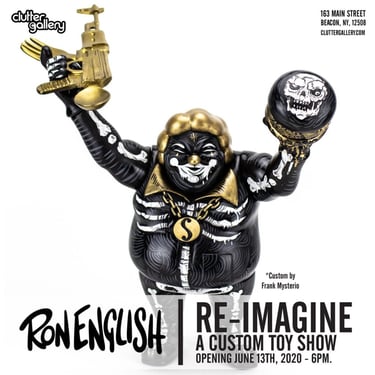
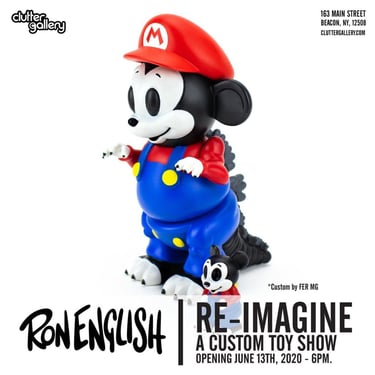
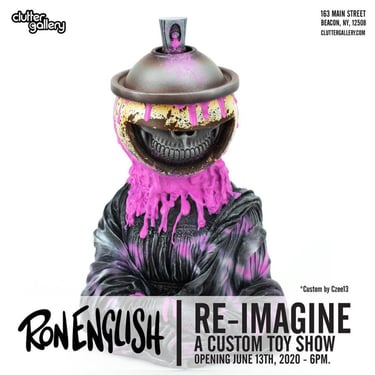
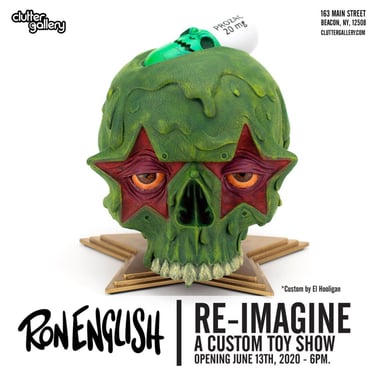
We didn’t lose our inner child. We turned it into Art.
You collecting, or just hoarding what the algorithm spoon-feeds you?
contact
© 2025. All rights reserved.
